现代英语词汇学概论6 polysemy and homonymy
- 格式:ppt
- 大小:375.00 KB
- 文档页数:63
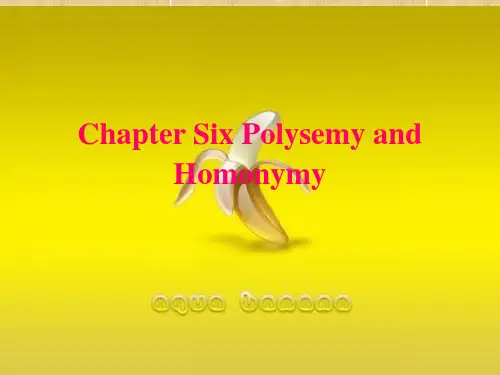
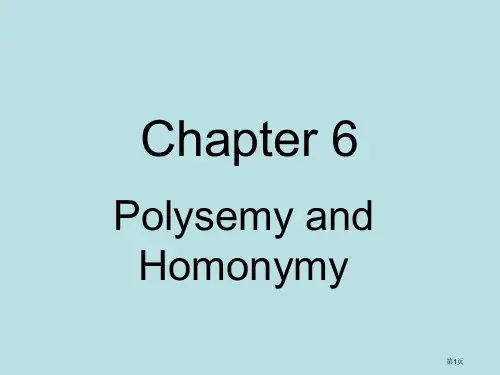
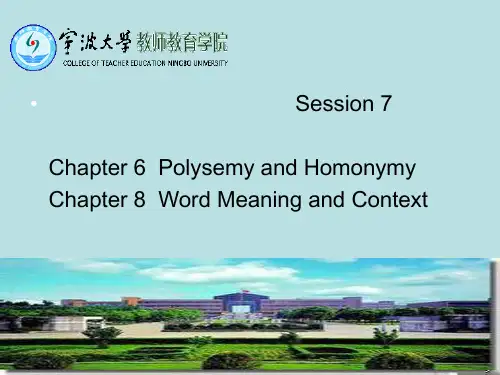
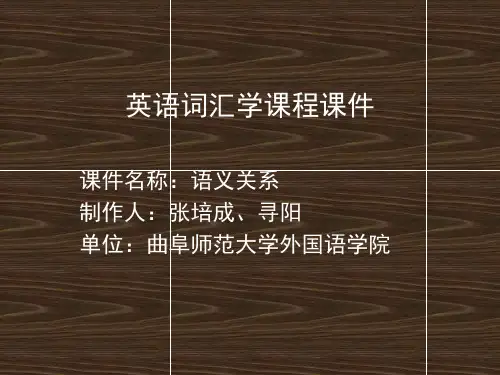
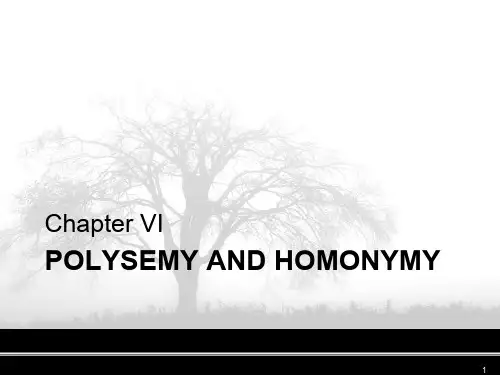
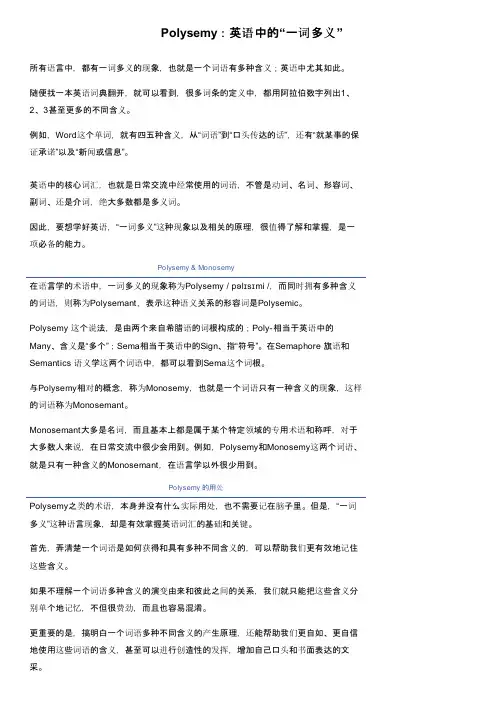
Polysemy:英语中的“一词多义”所有语言中,都有一词多义的现象,也就是一个词语有多种含义;英语中尤其如此。
随便找一本英语词典翻开,就可以看到,很多词条的定义中,都用阿拉伯数字列出1、2、3甚至更多的不同含义。
例如,Word这个单词,就有四五种含义,从“词语”到“口头传达的话”,还有“就某事的保证承诺”以及“新闻或信息”。
英语中的核心词汇,也就是日常交流中经常使用的词语,不管是动词、名词、形容词、副词、还是介词,绝大多数都是多义词。
因此,要想学好英语,“一词多义”这种现象以及相关的原理,很值得了解和掌握,是一项必备的能力。
Polysemy & Monosemy在语言学的术语中,一词多义的现象称为Polysemy / pəlɪsɪmi /,而同时拥有多种含义的词语,则称为Polysemant,表示这种语义关系的形容词是Polysemic。
Polysemy 这个说法,是由两个来自希腊语的词根构成的;Poly-相当于英语中的Many、含义是“多个”;Sema相当于英语中的Sign、指“符号”。
在Semaphore 旗语和Semantics 语义学这两个词语中,都可以看到Sema这个词根。
与Polysemy相对的概念,称为Monosemy,也就是一个词语只有一种含义的现象,这样的词语称为Monosemant。
Monosemant大多是名词,而且基本上都是属于某个特定领域的专用术语和称呼,对于大多数人来说,在日常交流中很少会用到。
例如,Polysemy和Monosemy这两个词语、就是只有一种含义的Monosemant,在语言学以外很少用到。
Polysemy 的用处Polysemy之类的术语,本身并没有什么实际用处,也不需要记在脑子里。
但是,“一词多义”这种语言现象,却是有效掌握英语词汇的基础和关键。
首先,弄清楚一个词语是如何获得和具有多种不同含义的,可以帮助我们更有效地记住这些含义。
如果不理解一个词语多种含义的演变由来和彼此之间的关系,我们就只能把这些含义分别单个地记忆,不但很费劲,而且也容易混淆。
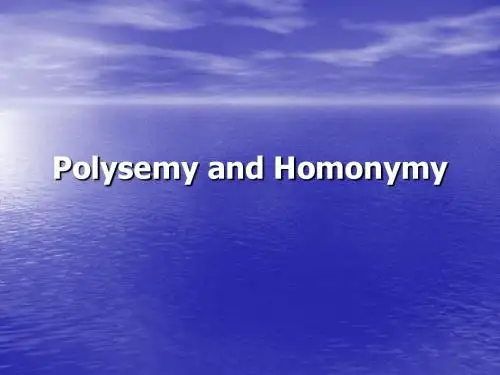
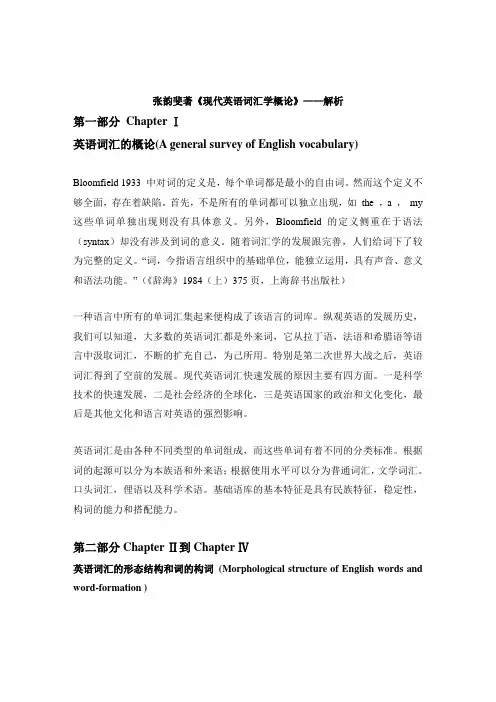
张韵斐著《现代英语词汇学概论》——解析第一部分Chapter Ⅰ英语词汇的概论(A general survey of English vocabulary)Bloomfield 1933 中对词的定义是,每个单词都是最小的自由词。
然而这个定义不够全面,存在着缺陷。
首先,不是所有的单词都可以独立出现,如the ,a ,my 这些单词单独出现则没有具体意义。
另外,Bloomfield的定义侧重在于语法(syntax)却没有涉及到词的意义。
随着词汇学的发展跟完善,人们给词下了较为完整的定义。
“词,今指语言组织中的基础单位,能独立运用,具有声音、意义和语法功能。
”(《辞海》1984(上)375页,上海辞书出版社)一种语言中所有的单词汇集起来便构成了该语言的词库。
纵观英语的发展历史,我们可以知道,大多数的英语词汇都是外来词,它从拉丁语,法语和希腊语等语言中汲取词汇,不断的扩充自己,为己所用。
特别是第二次世界大战之后,英语词汇得到了空前的发展。
现代英语词汇快速发展的原因主要有四方面。
一是科学技术的快速发展,二是社会经济的全球化,三是英语国家的政治和文化变化,最后是其他文化和语言对英语的强烈影响。
英语词汇是由各种不同类型的单词组成,而这些单词有着不同的分类标准。
根据词的起源可以分为本族语和外来语;根据使用水平可以分为普通词汇,文学词汇。
口头词汇,俚语以及科学术语。
基础语库的基本特征是具有民族特征,稳定性,构词的能力和搭配能力。
第二部分Chapter Ⅱ到Chapter Ⅳ英语词汇的形态结构和词的构词(Morphological structure of English words and word-formation )(一)词素(Morphemes)单词是有词素(morphemes)构成的。
词素即英语语言中有意义的最小单位,同时具有声音和意义。
单词可以有一个或一个以上的词素组成。
如:nation 是一个词素,national有nation+al 两个词素。
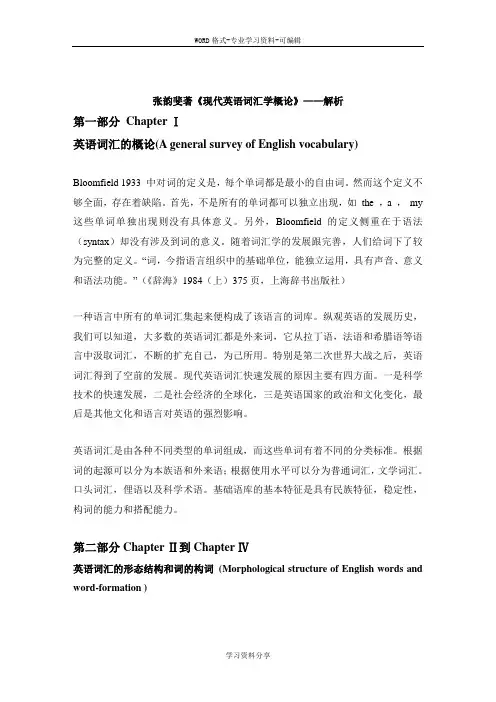
张韵斐著《现代英语词汇学概论》——解析第一部分Chapter Ⅰ英语词汇的概论(A general survey of English vocabulary)Bloomfield 1933 中对词的定义是,每个单词都是最小的自由词。
然而这个定义不够全面,存在着缺陷。
首先,不是所有的单词都可以独立出现,如the ,a ,my 这些单词单独出现则没有具体意义。
另外,Bloomfield的定义侧重在于语法(syntax)却没有涉及到词的意义。
随着词汇学的发展跟完善,人们给词下了较为完整的定义。
“词,今指语言组织中的基础单位,能独立运用,具有声音、意义和语法功能。
”(《辞海》1984(上)375页,上海辞书出版社)一种语言中所有的单词汇集起来便构成了该语言的词库。
纵观英语的发展历史,我们可以知道,大多数的英语词汇都是外来词,它从拉丁语,法语和希腊语等语言中汲取词汇,不断的扩充自己,为己所用。
特别是第二次世界大战之后,英语词汇得到了空前的发展。
现代英语词汇快速发展的原因主要有四方面。
一是科学技术的快速发展,二是社会经济的全球化,三是英语国家的政治和文化变化,最后是其他文化和语言对英语的强烈影响。
英语词汇是由各种不同类型的单词组成,而这些单词有着不同的分类标准。
根据词的起源可以分为本族语和外来语;根据使用水平可以分为普通词汇,文学词汇。
口头词汇,俚语以及科学术语。
基础语库的基本特征是具有民族特征,稳定性,构词的能力和搭配能力。
第二部分Chapter Ⅱ到Chapter Ⅳ英语词汇的形态结构和词的构词(Morphological structure of English words and word-formation )(一)词素(Morphemes)单词是有词素(morphemes)构成的。
词素即英语语言中有意义的最小单位,同时具有声音和意义。
单词可以有一个或一个以上的词素组成。
如:nation 是一个词素,national有nation+al 两个词素。
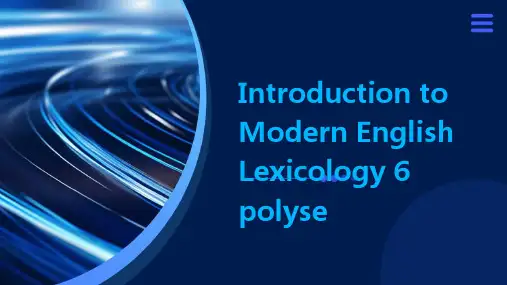
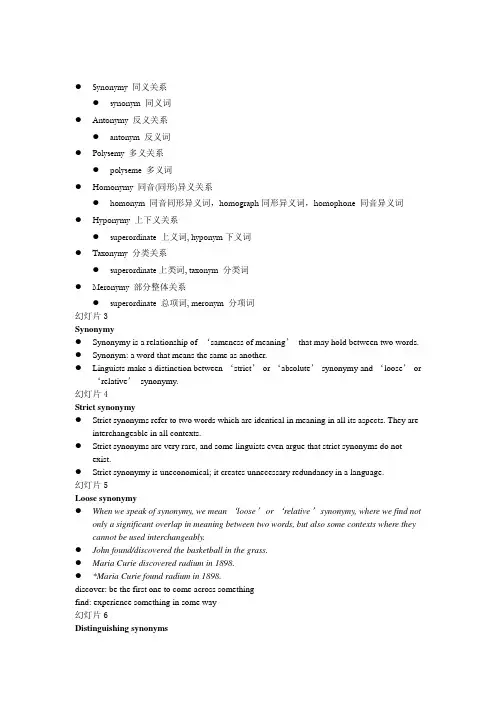
●Synonymy 同义关系●synonym 同义词●Antonymy 反义关系●antonym 反义词●Polysemy 多义关系●polyseme 多义词●Homonymy 同音(同形)异义关系●homonym 同音同形异义词,homograph同形异义词,homophone 同音异义词●Hyponymy 上下义关系●superordinate 上义词, hyponym下义词●Taxonymy 分类关系●superordinate上类词, taxonym 分类词●Meronymy 部分整体关系●superordinate 总项词, meronym 分项词幻灯片3Synonymy●Synonymy is a relationship of ‘sameness of meaning’that may hold between two words.●Synonym: a word that means the same as another.●Linguists make a distinction between ‘strict’or ‘absolute’synonymy and ‘loose’or‘relative’synonymy.幻灯片4Strict synonymy●Strict synonyms refer to two words which are identical in meaning in all its aspects. They areinterchangeable in all contexts.●Strict synonyms are very rare, and some linguists even argue that strict synonyms do notexist.●Strict synonymy is uneconomical; it creates unnecessary redundancy in a language.幻灯片5Loose synonymy●When we speak of synonymy, we mean ‘loose’or ‘relative’synonymy, where we find notonly a significant overlap in meaning between two words, but also some contexts where they cannot be used interchangeably.●John found/discovered the basketball in the grass.●Maria Curie discovered radium in 1898.●*Maria Curie found radium in 1898.discover: be the first one to come across somethingfind: experience something in some way幻灯片6Distinguishing synonyms●We often take the following things into consideration when we try to find the differencesbetween synonyms.●Different English dialects●Different stylistic meanings●Different connotative meanings幻灯片7Synonyms from different dialects●Some synonym pairs differ in that they belong to different dialects of English. Here are someexamples of synonyms from British and American English:BrE AmE BrE AmElift elevator farm ranchlawyer attorney biscuit cookierubbish garbage pavement sidewalk幻灯片8Synonyms with different stylistic meanings●One of a pair of synonyms may be used in a more formal context than the other. Here aresome examples of synonym pairs.Informal Formal Informal Formaldie decease daddy fatherblame chide guy manwest occidental praise eulogy幻灯片9Synonyms with different connotative meanings●Synonyms may have different emotive associations (connotative meanings).famous notorious(disreputably) misuse abuse(of privilege orpower)ambiguous equivocal(deliberately) new novel(strikingly)hate loathe(with disgust) obtain procure(with effort)幻灯片10Source of synonyms●Why are there so many synonyms in English?●The primary reason for this has to do with the heavy borrowing from other languages,especially from French and Latin.English French Latinask question interrogatetime age epochbegin commencebuy purchase幻灯片11Antonymy (反义关系)●Antonymy is a relationship of ‘meaning opposition’ that may hold between twowords.●Antonyms can be defined as words which are opposite in meaning.●Major types of antonyms:●Gradable antonyms●Contradictory or complementary antonyms●Converse antonyms幻灯片12Gradable antonyms●Gradable antonyms include pairs like the following:●beautiful ugly●expensive cheap●fast slow●hot cold●long short●rich poor●wide narrowThese pairs are called gradable antonyms because they do not represent a more/less relation. The words can be the end-points of a continuum (连续体).Since they are gradable, they allow comparison.幻灯片13Contradictory (complementary) antonyms●Contradictory antonyms include pairs like the following:●asleep awake●dead alive●on off●remember forget●win lose●true falseThese pairs are called contradictory antonyms because they represent an either/or relation.If you permit some behavior, then it is not forbidden.Since they are not gradable, they do not allow comparison.幻灯片14Converse antonyms (逆行)●The following are examples of converse antonyms:●lend borrow●husband wife●above below●before after●behind in front of●buy sell●give receive●parent child●speak listenLend is the converse of borrow and vice versa; i.e. the substitution of one member for the other does not change the meaning of a sentence if it is accompanied by the change of subject and object.John lent Mary five dollars.=Mary borrowed five dollars from John.幻灯片15Contradictory antonyms vs. Converse antonyms1,The bridge is above the river.The river is below the bridge. Converse antonyms are relational antonyms.2,This behavior is allowed.This behavior is not prohibited. Contradictory antonyms are either/or antonyms.幻灯片16Polysemy●When a word is first coined, it is always the case (true) that it has only one meaning(monosemic). But in the course of development, the same symbol may be used to express new meanings. The result is polysemy.●Polysemy shows the economy and efficiency of human languages.幻灯片17Two processes leading to polysemy●There are two important processes in the development of meaning:●Radiation (发散)●Concatenation(串联)幻灯片18Radiation●Radiation is a process in which the primary meaning stands in the center, and the derivedmeanings radiate from it in every direction like rays.●All the derived meanings can be traced back to the primary meaning.幻灯片19Radiation Example: faceWe can get the derived meanings by extension, narrowing, analogy, transfer, etc.the front of the head(Primary Meaning): 1a person,2self-respect,3outward appearance,4the surface of a thing,5countenance(Derived Meaning)幻灯片20Concatenation●Concatenation is a process in which the meaning of a word moves gradually from its primarymeaning by successive shifts, like the links of a chain, until there is no connection between the meaning that is finally developed and the primary meaning.●Unlike radiation where each of the derived meaning is directly related to the primarymeaning, concatenation is a process where each of the later meaning is related only to the preceding one.1→2→3→4→5→6幻灯片21Concatenation Example: candidateA a person dressed in whiteA+B(bridging context) a white robed applicant for office (because the Romans wore white robes when standing for office)B a person taking an examinationThere is no connection between A and B, because the middle link (A+B) has vanished.The primary meaning A has also vanished. Now the derived meaning has become the central meaning.幻灯片22Homonymy●Homonymy is the relation between two words that are spelled or pronounced in the sameway but differ in meaning.●Such words are called homonyms.●lie vi. / lie vi. -- perfect homonyms●tear n./ tear vt.--homographs●coarse/course --homophones幻灯片23Perfect homonyms●Perfect homonyms: words identical in both sound and spelling, but different in meaning●bank: n./ bank: n.●bear: n./ bear: vt.幻灯片24Homographs●Homographs: words identical only in spelling but different in sound and meaning.●bow: vi. to bend one’s head as a greeting●bow: n. the device used for shooting arrows●sow: n. female pig●sow: vi. to scatter seeds●perfect: v. /- ’-/●perfect: adj. /’- -/幻灯片25Homophones●Homophones: words identical only in sound but different in spelling and meaning.●sun/son●deer/dear●right/write●pair/pear●stationary/stationery幻灯片26Differentiation of perfect homonyms from polysemous wordsthe same lexeme which has several different meaningsperfect homonymshaving different sourcespolysemous wordsdeveloped from the same sourcedifferent lexemes which have the same form幻灯片27The use of polysemy and homonymy●Polysemous words and homonyms are often used as puns, to achieve certain literary effect,such as humor, irony, etc.●Lewis Carroll’s Alice’s Adventure in Wonderland●“How is bread made?”●“I know that!”Alice cried eagerly. “You take some flour.”●“Where do you pick the flower?”the White Queen asked. “In a garden, or in the hedges?”●“Well, it isn’t picked at all,”Alice explained: “it’s ground.”●“How many acres of ground?”said the White Queen.幻灯片28Hyponymy●Hyponymy is the sense relationship that relates words hierarchically. The underlyingobservation is that some words have a more general meaning, while others have a morespecific meaning, while referring to the same entity.We are not going to have any food today.We are not going to have any vegetables today.幻灯片29FOOD have a more general meaning(superordinate): FRUIT, MEAT, VEGETABLE(They are subordinate terms. They are hyponyms of the superordinate term FOOD.)MEAT: BEEF, PORK, MUTTON(They are subordinate terms. They are hyponyms of the superordinate term MEA T.)VEGETABLE have a more specific meaning:(CABBAGE,CELERY,SPINACH)FRUIT: APPLE, PEACH, ORANGE(Reading from the bottom of the hierarchy, ORANGE is a ‘kind of’ fruit, which is a kind of food.)幻灯片30Taxonymy●Taxonymy is the relationship in which “X is a kind of Y”(Cruse 1986).●Not all hyponyms are good taxonyms.●Hyponyms large spoon, deep spoon are not “a kind of spoon”●Taxonyms teaspoon, soup spoon are “a kind of spoon”幻灯片31Taxonymy - Focal orientation●Focal orientation: this is a perspective that the taxonym and superordinateterm must share so that the relationship works● A blonde is not a kind of woman because blonde has a hair color focalorientation that woman lacks.幻灯片32Taxonymy –distinctive feature●It appears that a taxonym must engage with the meaning of its superordinate ina particular way, by further specifying what is distinctive about it. (p.121)● A strawberry blonde is a type of blonde.●(Distinctive f. of blonde: fair hair)●?A blonde is a type of woman.●(Distinctive f. of woman: sex)●?A stallion is a type of horse.●(Distinctive f. of stallion: sex)幻灯片33Hierarchical characteristic of Taxonymy●Pine is a kind of conifer, which is a kind of tree, which is a kind of plant.幻灯片34Taxonymy vs HyponymyHyponymy分类关系具有严格的层次性,一般不超过五层,每个层次的词项必须严格地遵守同一分类标准;而上下义关系中的词项虽然也能够划分层次,但没有严密的定义标准,对层次的数目也没有规定。
A Brief View on Polysemy and Homonymy【Abstract】Polysemy and homonymy,as important conceps in lexical semantics,explore the relation between different senses.They are employed to achieve humor,irony and dramatic power.【Key words】Polysemy;Homonymy;Distinction;Stylistic value1 IntroductionThe study of polysemy and homonymy has a long history on the philosophy of language,linguistics,psychology,and hterature,The complex relation between meanings and words were first noted by Stoics.They observed that one word could carry diferent meanings.Through the sttbsequent research into the issue of polysemy and homonymy,it is found that there exists an extensive grey area between them.How to distinguish the two is an important issue lying in front of the researchers.Th e paper here will analyze this problem from four angles.Polysemy and homonymy are rarely a problem in language use because of the adoption of contextual cues.Th ey are sometimes used as a source of puns to achieve stylistic value such as humor and irony and to heightened dramatic power,which embody the richness and coincidence of language.2 A Brief Elucidation of Polysemy and HomonymyDefinition of Polysemy and HonomymyThe coexistence of several meanings in a word is called polysemy.Th e word polysemy comes from Neo—Latin polysemia(polymany,sema—sign),that is,having or characterized by many meanings for a single word or phrase.Polysemy seems to be motivated by metaphoric thought,that is,the relation between two polysemes seem to be the result of a certain underlying metaphor for shape,size,position,outward appearance,function and so on.Part of the lexical entry for head in English is used to illustrate this:① part ofthe body containing the brain.② the top of anything(1iterally or metaph orically)that resembles the head in shape③ the pemon who is the chief or leader.Clearly,(2)is motivated by shape and(3)by function.Homonymy is usually viewed to hold between word—forms whose senses are completely unrelated.A word witll at least two elltirely distinct meanings yet sharing a lexical form is said to be homonymous.One of the most commonly cited examples of homonymous words is bank,which has a financial institution sense and an edge of a river sense.Th ese senses seem clearly unrelated,and the fact that they are associated with the same word form seems purely accidenta1.Homonyms can be categorized into three types:total homonyms,homophone and homograph.In the first type,lexemes will be absolutely homonymous if they are formally identical inboth the phonic and graphic medium such a8 the verb lie(to be in or take a flat position)and lie(make a false statement with intention of deceiving to say something untrue).The second type is homophone.Homophones are partial ones by sharing phonologically features,such as flour and flower.The third type is homographs which explore the meaning of different words that look alike,e.g.1ead(guide or direct to go in a certain direction)and lead(a soft,heavy,bluish—grey meta1)a homographs.Distinction Between Polysemy and HomonymyIn fact,polysemy is very similar to homonymy.Two words can be polysemous when their senses are somehow related,as long fit8 they are not equal,while homonymy is usually viewed to hold between word forms whose senses are completely unrelated. Given that we have a written form with diferent meanings,are we to say it is one word with diferent meanings(polysemy)or two diferent words with the same shape(homonymy)?What are the criteria that enable 118 to distinguish between polysemy and homonymy?There are some possible ways of answering these questions.Firstly,dictionary usually ba- ses their decision upon etymology .If it is known that idenficM forms have one origin,even if they have diferent meanings,they are treated as polysemic and given a single entry in a dictionary.If it is know that they have diferent origins,they are treated as homonymous and given separate entries.Thus,on the ground of a shared etymological knowledge,table(furniture)and table(arrangement of data)are polysemic,while pupil(student)and pupil(the round opening in the middle of eye)are homonymous.Secondly,it is reasonable to suggest that where the diferences are regular and to some degree pre- dictable.we have polysemy rather than homonymy.One of the most familiar kinds of regular relationship between meanings is that of metaphor where a word appears to have both a literal meaning and transfered meaning.A good example is the words for part of body,such as fot in his fot and the fot of the mountain.Th us,fot is more 1ikely to be regarded as a polysemic word with literal meaning and transfered meaning.Thirdly,another diferent way of attempting toestablish polysemy rather than homonymy is to look for a central meaning.Around the central meaning are radiations of other meanings.The word table as a polysemic word is a good illustration.The core of meaning is a piece of furniture,and then appeam other ones extending fromit,such as a dish and people sitting at table.Fourthly,it is tempted to say that where the antonym is the same we have polysemy,and the diference of antonym implies homonymy.For example,the same word black can refer to a kind of heavy color and also black people Negro.Its antonym white correspondingly has two meanings:a light kind of color;people of European descent.Thus black belongs to polysemic word.While the word lights is concerned,they have diferent autonyms:light—heavy,light—dark.So they are usually seen as homonyms.3 The Stylistic Value of Polysemy and HomonymyAlthough polysemy and homonymy carry diferent meanings, they are rarely a problem in language use.The reason is the adoption of context,which plays a very important role in the hearer interpreration of words.Some proper ambiguities are intentionally aroused by employing polysemy and homonymy with the purpose of stylistic va1ue.Achieving HumorPolysemy and homonymy can be used as pun to indicate the employer’s intention of making fun.A good example is the following pas-sage from Lewis Carrol’s Alice’s Adventure in Wonderland.“How is bread made?”“I know that!”Alice cried eagerly.“You take some flour.”“Where do you pick flowers? ”the White Queen asked,“In the garden or in the hedge?”“Well,itn’t picked at all,”Alice explained,“it is ground.”“How many acres ofground?”said the White Queen.This passage makes use of homonymous words:flour and flower,and polysemic word ground.They are specified differently by Alice and the White Queen.Because there is no connection between the questions and the answers,the audience may feel funny when reading their dialogue.Achieving IronyPolysemic words and homonymous words are not only good can.didates for humor;they can also produce other efects such as irony.For example:Where is Washington?He is dend.I mean the capital of the United States.They loaded it all to Europe.Now do you promise to support the constitution ?Me? How can I? I’ve got a wife and three children to support.The dialogue above is said to be an oral investigation held among constituents when the presidential election is coming.Puns are skillfully used on three words:Washington,capital and support.The proper employment of polysemy implicitly satirizes the politics in the US.Heighten Dramatic PowerDramatic power can be heightened through the ingenious use of puns,and this is another stylistic value of polysemy and homonymy.Here is a right illustration.We must all hang together,or we shall all hang separately.This is a maxim ven by Benjamin Franklin,who argued people should unite and persist to avoid being strangled by the enemy.His mastery of words enhances the efect of political dissemination and the power of appea1.More sun and airfor you son and heir.This is a quotation from an advertisement of a lido.By making use of two sets of homophones(sun/son and air/heir),the lido convinces that thereis adequate sunshine and flesh air which are beneficial to the child and successor.It is believed that this is a unque message for the tourists who are inclined to be attracted by its cleverness and skillfulness.4 ConclusionPolysemy and homonymy,as important concepts in lexical semantles,explore the relation between different senses.The distinction between polysemy and homonymy is important because it separates the principled from the accidenta1.Their pragmatic functions are noticeable,for they are stylistically useful to achieve such contextual effects as humor,irony,and heightened dramatic power.Due to the ingenious employment of polysemy and homonymy,people are impressed with their semantic power and the richness of lan guage.Bibliography[1] ZhangYunfei.An Introduction to Modem EnglishLexicology[M].Beijing:Beijing Normal University Press,2004.[2] CaoWutang.Concise English Lexicology[M].Shandong:Shandong Education Press,1992.[3] QinHonglin,JiaDelin.A Study of English Ambiguity[_M].Jiangsu:Jiangsu Education Press,1991.[4] QinXiubai.Elementary English Stylistics[M].Hunan:Hunan Education Press,1986.[5] Yael Ravin,Claudia Leacock(ed).Polysemy[M].0 rd:Oxford University Press,2000.[6] F.R.palmer.Semantics[M].Cambridge:Cambridge University Press,l976。
Chapter 6 Polysemy and Homonymy⏹6.1 Polysemy 一词多义⏹6.2 Homonymy 同音同形异义⏹6.3 The Stylistic Value of Polysemy and Homonymy 一词多义与同音异义的文体价值6.1 Polysemy 一词多义Polysemy: A term used in semantic analysis to refer to a lexical item which has a range of different meanings.*means that one single word has two or more senses at the same time.●Two approaches to polysemy :diachronic 历时的and synchronic 一时的,同步的●Two processes leading to polysemy1)Radiation辐射型:It is the process in which the primary or central meaning stands at thecenter while secondary meaning radiates from it in every direction like ray .*Though all the secondary meanings are independent of one another, they can all be traced back to the primary meaning.2)Concatenation连锁型: It is a semantic process in which the meaning of a word movesgradually away from its first sense by successive shifts ,like the links of a chain ,until thereis no connection between the sense that is finally developed and the primary meaning .*use relations between senses to master the different meanings of a polysemic word●Sense relations of polysemy1)original meaning vs. extended meaning 原始意义vs.引申意义2)universal meaning vs. particular meaning 普遍意义vs.特殊意义3)abstract meaning vs. concrete meaning 抽象意vs.特殊意义4)literal meaning vs. figurative meaning字面意义vs.比喻意义6.2 Homonymy 同音同形异义Homonymy: words which though different in meaning ,are pronounced alike ,or spelled alike ,or both .Eg.light(光)light(轻的);bark(吠)bark(树皮);flower(花)flour(面粉)●Three types of homonyms:1)Perfect homonyms完全同形同音异义词:Words identical in spelling but different in meaning .E.g.1).poppop /p p/ n.流行歌曲pop/p p/n.爸爸pop/p p/n.砰的一声2).lastlast /la:st/a.最后的last/la:st/v.持续last/la:st/n.鞋楦头现代英语词汇学概论最强版复习资料chapter62)Homophones同音异义词:Words identical in sound but different in spelling and meaning.Eg. air空气–heir继承人,后嗣bear忍受,熊–bare空的,赤裸的dear 亲爱的–deer鹿3)Homograph同形异音异义词:Words identical in spelling but different in sound and meaning .Eg. lead sow tear prayerSources of homonyms1.Phonetic convergenceUnder the influence of phonetic convergence ,two or more words whichonce were different in sound forms take on the same pronunciation thespoken language .E.g. melo –meal bean –been beat –beet flea –flee heal –heel2.Semantic divergenceWhen two or more meanings of the same word drift apart to such an extentthat there will be no obvious connection between them ,polysemy will giveplace to homonymy .E.g. flour –flower metal –mettle3.Foreign influenceE.g. host –one who entertains guest [L hospitis ]host –a large number ,an army [L hostis ,army ,hostile force ]4.ShorteningThis source is of decidedly subsidiary importance in formal writing but haswidespread influence in everyday speech.E.g. pop –popular (music )-to thrust ,to push (up ) 推6.3 The Stylistic Value of Polysemy and Homonymy一词多义与同音异义的文体价值Context plays a very important role in the hearer 's interpretation of words of two special types: different words of like form(homonymy)and words of several meanings (polysemy ).*Polysemic and homonymous words are stylistically useful to achievehumour or irony ,or to heighten dramatic effect .。